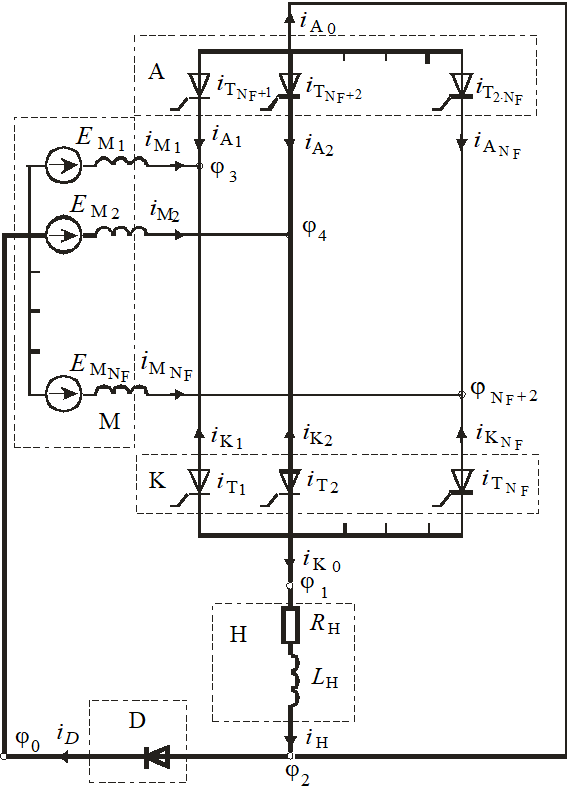Method of dynamic parameters for mathematical modelling of switching processes of valves closing of semiconductor converters
DOI:
https://doi.org/10.20998/2074-272X.2022.3.05Keywords:
valve, switching, inverse current, adequacy level, mathematical model, software codeAbstract
A method has been developed for mathematical modeling of valve frequency converters (VFC) based on an analysis of the nature of the occurrence and patterns of the flow of inverse current of valves when they are locked using the dynamic parameters of valves, which are series-connected inductance and active resistance, changing in accordance with the pattern of concentration dynamics charges in semiconductor structures (bases, emitters and p-n junctions. Taking into account the presence of the inverse current of semiconductor valves significantly increases the level of adequacy of mathematical modeling of VFCs of arbitrary structure and purpose and in arbitrary modes of their operation, including asymmetric and emergency transient electromagnetic processes of electrotechnical complexes with VFCs, not only during the time interval of switching (closing) of valves, but throughout the entire time modeling.
References
Shapoval I.A., Mykhalskyi V.M., Doroshenko A L. Speed control of the doubly-fed induction machine with controlled converters in the stator and rotor circuits. Technical Electrodynamics, 2017, no. 6, pp. 18-25. (Ukr). doi: https://doi.org/10.15407/techned2017.06.018.
Mazurenko L.I., Lishchenko A.I. Asinkhronnye generatory s ventil'nym i ventil'no-emkostnym vozbuzhdeniem dlia avtonomnykh energoustanovok [Asynchronous generators with valve and valve-capacitive excitation for autonomous power plants]. Kyiv, Naukova Dumka Publ., 2011. 272 p. (Rus).
Mazurenko L.I., Vasyliv K.M., Dzhura O.V., Kotsiuruba A.V. Simulation model and control algorithm for isolated hydro-wind power system. Technical Electrodynamics, 2020, no. 1, pp. 17-26. (Ukr). doi: https://doi.org/10.15407/techned2020.01.017.
Novikov M.A., Panfilov Zh.I., Remizevich T.V., Rashitov P.A. Analysis of the processes of simultaneous switching of thyristor bridges in converters with multi-winding transformers. Elektrichestvo, 2013, no. 6, pp. 29-35. (Rus).
Shydlovska N.A., Zakharchenko S.M. Progress of semiconductor discharge-pulse systems for processing granular conductive media. Technical Electrodynamics, 2020, no. 3, pp. 69-78. (Ukr). doi: https://doi.org/10.15407/techned2020.03.069.
Dzhiudzhi L., Pelli B. Silovye poluprovodnikovye preobrazovateli chastity [Power semiconductor frequency converters]. Moscow, Energoatomizdat Publ., 1983. 400 p. (Rus).
Zhemerov G.G. Tiristornye preobrazovateli chastoty s neposredstvennoi sviaz'iu [Thyristor frequency converters with direct connection]. Moscow, Energiia Publ., 1977. 280 p. (Rus).
Zhemerov G.G., Krylov D.S., Mashura A.V. Energy efficiency of the subway electrical supply system with electrical energy recovery at braking. Electrical Engineering & Electromechanics, 2019, no. 5, pp. 25-30. doi: https://doi.org/10.20998/2074-272X.2019.5.04.
Khlopenko N.J. Calculation and design of a robust speed controller of a frequency-controlled induction electric drive. Electrical Engineering & Electromechanics, 2020, no. 3, pp. 31-36. doi: https://doi.org/10.20998/2074-272X.2020.3.05.
Butkevych O.F., Chyzhenko O.I., Popovych O.M., Trach I.V. An influence of the facts upon an electrical network’s mode during direct start-up of an asynchronous machine in the complex load’s composition. Technical Electrodynamics, 2018, no. 6, pp. 62-68. (Ukr). doi: https://doi.org/10.15407/techned2018.06.062.
Bibik O.V., Mazurenko L.I., Shykhnenko M.O. Formation of characteristics of operating modes of switched reluctance motors with periodic load. Electrical Engineering & Electromechanics, 2019, no. 4, pp. 12-16. doi: https://doi.org/10.20998/2074-272X.2019.4.02.
Onikienko Y.O., Pilinsky V.V., Popovych P.V., Lazebnyi V.S., Smolenska O.I., Baran V.S. Modelling of operation modes and electromagnetic interferences of gan-transistor converters. Electrical Engineering & Electromechanics, 2020, no. 3, pp. 37-42. doi: https://doi.org/10.20998/2074-272X.2020.3.06.
Rymsha V.V., Radimov I.N., Gulyy M.V., Merkulov I.V. Motorsolve software package: verification of parameters and characteristics of the brushless permanent magnet motor. Electrical Engineering & Electromechanics, 2019, no. 5, pp. 20-24. https://doi.org/10.20998/2074-272X.2019.5.03.
Tonkal' V.E., Rudenko V.S., Zhuikov V.Ia. Ventil'nye preobrazovateli peremennoi struktury [Valve converters of variable structure]. Kyiv, Naukova Dumka Publ., 1989. 336 p. (Rus).
Plakhtyna E.G. Matematicheskoe modelirovanie elektromashinno-ventil'nykh system [Mathematical modeling of electromachine-valve systems]. Lvov, Vishcha Shkola Publ., 1986. 164 p. (Rus).
Dizhur D.P. Method of simulation on a digital computer of valve converter circuits. Izvestia of the Research Institute of Direct Current, 1970, no. 16, pp. 7-9. (Rus).
Fil'ts R.V. Matematicheskie osnovy teorii elektromekhanicheskikh preobrazovatelei [Mathematical foundations of the theory of electromechanical converters]. Kyiv, Naukova Dumka Publ., 1979. 208 p. (Rus).
Hutsaliuk V.Y., Yurchenko O.M., Zubkov I.S., Pazenko V.P. Serial connecting of resonant voltage inverters for high-frequency induction heating equipment. Technical Electrodynamics, 2018, no. 4, pp. 70-73. (Ukr). doi: https://doi.org/10.15407/techned2018.04.070.
Belov G.A., Serebriannikov A.V., Garanin S.G. Calculation and analysis of processes in reversible pulse converters with two-way differential pulse-width modulation. Elektrichestvo, 2013, no. 2, pp. 42-63. (Rus).
Goriakin D.V., Mytsyk G.S. Study of the operating modes of a three-phase bridge inverter circuit. Elektrichestvo, 2012, no. 5, pp. 23-31. (Rus).
Mazurenko L.I., Vasyliv K.M. The law of the electric magnetic processes of the security exercise systems of the autonomous asynchronized generator on the case of the cascade three-phase three-flexible voltage modulator. Technical Electrodynamics, 2018, no. 6, pp. 46-49. (Ukr). doi: https://doi.org/10.15407/techned2018.06.046.

Downloads
Published
How to Cite
Issue
Section
License
Copyright (c) 2022 K. M. Vasyliv

This work is licensed under a Creative Commons Attribution-NonCommercial 4.0 International License.
Authors who publish with this journal agree to the following terms:
1. Authors retain copyright and grant the journal right of first publication with the work simultaneously licensed under a Creative Commons Attribution License that allows others to share the work with an acknowledgement of the work's authorship and initial publication in this journal.
2. Authors are able to enter into separate, additional contractual arrangements for the non-exclusive distribution of the journal's published version of the work (e.g., post it to an institutional repository or publish it in a book), with an acknowledgement of its initial publication in this journal.
3. Authors are permitted and encouraged to post their work online (e.g., in institutional repositories or on their website) prior to and during the submission process, as it can lead to productive exchanges, as well as earlier and greater citation of published work.




